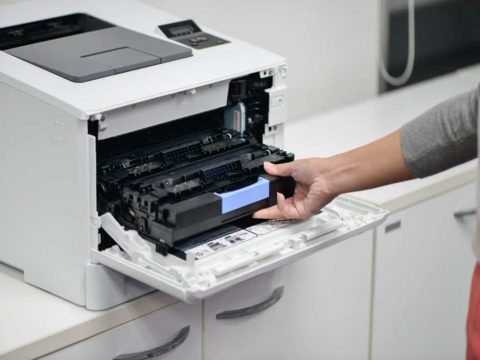What Is The Composition Of Toner? Is It Harmful To Human Body?
What is the composition of toner? Is it harmful to human body?
Toner, also known as toner, is not mainly composed of carbon, most of which are composed of resin and carbon black, charge agent, magnetic powder, etc. The carbon powder is melted into the paper fibers at high temperature, and the resin is oxidized into a gas with a pungent odor, which is what everyone calls 'ozone'. The only benefit of this gas is to protect the earth and reduce the harm of solar radiation. However, it is harmful to the human body itself, it will stimulate the human mucous membranes, it is easy to increase the incidence of asthma or nasal allergies, and even dizziness, vomiting and other phenomena.
Introduction to Toner
In printing machinery, toner is mainly used in laser printers. In order to improve economic efficiency and utilization, printers must add toner. After many toner cartridges are used up, users can refill them and continue to use them, so there are also separate toners sold on the market. Reduce costs by adding toner yourself. Since the toner cartridge is a sealed disposable consumable, adding toner by yourself will destroy the sealing performance of the toner cartridge and cause powder leakage. The particles of toner are generally measured in microns, which are invisible to the naked eye, and the toner is scattered into the air. It will pollute the use environment and office environment, resulting in an increase in PM2.5.
Production method of toner
According to different needs, toner production tends to be refined, colored and high-speed. At present, the production of carbon powder mainly adopts the pulverization method and the polymerization method.
Polymerization
Polymerization is a fine chemical toner technology, which includes (suspension polymerization, emulsion polymerization, microcapsule loading, dispersion polymerization, compression polymerization, chemical pulverization.)
The polymerization method is completed in the liquid phase, which can produce carbon powder with a lower melting temperature, which can meet the requirements of modern technology for energy saving and environmental protection. The particle size of the carbon powder is controlled by adjusting the amount of dispersant, stirring speed, polymerization time and concentration of the solution to achieve uniform composition, good color and high transparency. The carbon powder produced by the polymerization method has perfect particle shape, finer particle size, narrow particle size distribution and better fluidity. It can meet the requirements of modern printing technology such as high speed, high resolution and color.
Polymeric toner technology has been around for many years:
1972 - The first patented polymer toner appears.
70's and 80's - widely improved.
1993 - The first commercial monochrome toners appear.
1998 - The first commercial color toners appear.
The technological process of polymerized toner:
(resin monomer, pigment, dispersant, other reagents) →(ultrasonic dispersion) →(water, dispersant) →(full stirring) →(polymerization) →(washing) →(filtration separation) →(drying) →(after processing) → (finished product)
Crushing
The whole production process of the crushing method is as follows:
(Material selection) →(Material inspection) →(Ingredients) →(Pre-mixing) →(Kneading and extrusion) →(Pulverization and classification) →(Post-processing) →(Finished products) →(Inspection) →(Separation)
At present, the pulverization method is widely used in the toner processing industry to make toner.
The pulverization method can produce toner suitable for dry electrostatic copying: including two-component toner and one-component toner (including magnetic and non-magnetic). Because of the different developing process and charging mechanism, the proportion of ingredients and ingredients are also different.
Classification of toner
There are many ways to classify toner, mainly as follows:
According to the developing method: magnetic brush developing toner and waterfall developing toner
According to the developing electricity: positive toner and negative toner
By component: one-component toner and two-component toner
According to magnetic properties: magnetic carbon powder and non-magnetic carbon powder
According to the fixing method: hot pressing fixing toner, cold fixing toner and infrared radiation fixing toner
According to insulating properties: insulating carbon powder and conductive carbon powder
According to the manufacturing process of carbon powder, it is divided into: physical powder and chemical powder
According to the printing speed of laser printers, it is divided into: low-speed powder and high-speed powder
Determinants of Toner Quality
The evaluation of the comprehensive quality of toner mainly depends on these six factors: blackness, bottom gray, fixation, resolution, waste toner rate, and ghosting.
These factors are interrelated and affect each other. The reasons that affect these factors are explained below.
Blackness: The calculation of the blackness value is that the blackness value tester first emits a certain number of strong beams, hits the pattern to be measured, and then reflects back to the blackness value tester, calculates the absorbed beam, and then passes the fixed calculation program. the resulting value. The blackness value of the toner is not the higher the better the printing effect. The international blackness value standard (ie the original OEM) is 1.3. In order to meet the different needs of various industries, the average blackness value of the company's toner is generally controlled at about 1.4.
Bottom gray: The bottom gray is the blackness value of the blank space without words in the print proof sheet tested with a blackness tester. The main reasons that affect the bottom ash value are the electrical and magnetic properties of the carbon powder. The electromagnetic properties of toner are generally different for each type of printer. This is also one of the reasons for emphasizing dedicated fans. In addition, the bottom ash can also be caused by the printer or the toner cartridge. The bottom gray value of the toner should be controlled below 0.005, otherwise the print proof will be a little dirty.
Fusing Fastness: Fusing fastness refers to the ability of the toner attached to the surface of the paper to penetrate into the fibers after melting. The quality of resin is a major factor affecting the fastness of toner fixing
Resolution: Resolution refers to the dots per inch (DPI) that can be printed. The thickness of the toner particles will directly affect the resolution. At present, the main resolutions of toner are 300DPI, 600DPI and 1200DPI.
Waste toner rate: Waste toner rate refers to the proportion of waste toner produced by a certain amount of toner in normal printing. The waste toner rate directly affects the number of sheets printed by a certain amount of toner. The standard requires the waste toner rate of toner to be less than 10%.
According to the form of ghosting, it is divided into two types: positive ghosting and negative ghosting. Positive ghosting is what we usually call ghosting, that is, a text (or pattern) that is the same as it appears directly below the text (or other patterns) (paper direction), but the density value (blackness) is much lower than it. . Usually formed during the fixing process or the transfer process.
How to identify the pros and cons of toner
1. Appearance of toner: The standard appearance should be fine, uniform, without impurities, and without agglomeration. Impurities are generally made of recycled waste powder, which is more common in counterfeit original products. Among them, paper fibers, toner particles with poor chargeability, and other impurity particles have poor electromagnetic properties, which will cause light printing and background. Gray large and other print quality problems. At the same time, the risk of damage to the equipment and resulting failure is the greatest.
2. Fluidity: Good toner generally has very good fluidity. You can put 20g of toner on white paper and shake it back and forth to observe its fluidity. The fluidity will affect the Powder blackness, bottom gray, transfer rate.
3. Odor: Standard toner should be odorless or slightly aromatic. The odor of imported powder is generally aromatic. Most of the domestic powder has a serious tar smell, which will cause There is a strong smell during printing/copying, which is unbearable.
4. Stability: A good toner has no abnormality from the beginning of adding powder to the final printing of the powder. Stability also refers to the manufacturer's materials and process equipment. Generally, imported manufacturers have convenient and stable procurement of materials. And advanced process equipment, the stability is very strong.
The harm of toner to human body
Now, laser printers, electrostatic copiers, etc. are indispensable in the office, and these printing machines will release various types of fine particle toner, polluting the indoor air. Nowadays, such devices can be seen everywhere in homes, companies, and units. It is these machines that emit a large amount of fine particles, heavy metals and harmful gases, which make various office syndromes quietly popular in countries around the world. The typical symptoms are respiratory infections, headaches and The blood picture changes.
Generally speaking, in addition to carbon black, iron oxide and polyester, the toner components used in the toner cartridges on the market also contain many metal dusts, such as nickel, cobalt, and mercury. These metal dusts are harmful to the human body. , the content of different products varies. In addition, toner also contains well-known carcinogens, such as benzene, aldehydes, styrene and so on. Color printing toner is full of five poisons, such as tributyltin, a few millionths of a gram can endanger the secretion of human hormones, which can seriously lead to a decrease in the sperm count of men and infertility of women. Such a hazardous substance cannot be ignored, and Germany banned its use in shipbuilding in 2003.
In fact, more than ten years ago, Spanish scientists published a study in the journal The Lancet that warned that the dust released by xerographic copiers could cause lung disease. Shortly thereafter, the US environmental research agency EPA also came to a similar conclusion. As early as 2003, the German Dortmund Labor and Medical Protection Agency conducted an experiment: let the test mice inhale carbon dust, and soon after, the test mice grew tumors in their lungs. Similarly, the Bonn Institute for Labor Protection conducted similar experiments on mice and guinea pigs, but found no abnormalities. Both trials, however, found an "inflammatory response" when the animals inhaled the fine particles released by the device. Unfortunately, until now, people have not seen any hints about the harmful substances contained in toner in the instruction manuals of these devices.
The toner particles are harmful to the human body. The toner particles are very small and are easily suspended in the air and enter the human body through the respiratory tract. Moreover, the toner cannot be melted in the human body, and it is extremely difficult to excrete it. After the leaked toner particles are inhaled by the human body, it is difficult to excrete the body through metabolism, and harmful substances can even penetrate deep into the lungs and damage the lung tissue, which is more harmful than second-hand smoke. Therefore, long-term inhalation or one-time inhalation is very easy to suffer from respiratory diseases, insomnia, headache, dizziness, etc., and more seriously, it may cause serious diseases such as silicosis or incurable cancer.
On the other hand, printing machinery can also harm the environment. When they work, they generate a large amount of organic waste gas such as benzopyrene and dimethylnitrosamine due to the action of high-voltage electrostatic field. These organic gases are all pathogenic, teratogenic and carcinogenic substances. A recent study by researchers at the British Allergy Foundation also pointed out that office equipment also emits ozone gas. Although ozone can reduce the harm of solar radiation, high concentrations of ozone can be a scourge.
Toner Hazard Prevention
1. Use good quality products to avoid serious powder leakage caused by inferior products
2. When using the device, do not disassemble the cover without authorization, which will cause toner dust to scatter in the air.
3. To maintain ventilation, windows should be opened frequently in the office for ventilation
4. In the office, keep some green plants, because plants have many functions such as absorbing carbon dioxide, releasing oxygen, adsorbing dust, and sterilizing, which can improve the quality of indoor air and benefit physical and mental health.
5. Eat more fruits and vegetables. Different types of fruits and vegetables have different health values, which can avoid the negative effects caused by excessive intake of certain substances.
Recommended Toner Brands
Original Toner: HP, Canon, Epson, Samsung, Brother, Lenovo
Compatible Toner: Ti-FAITH Toner Cartridge


